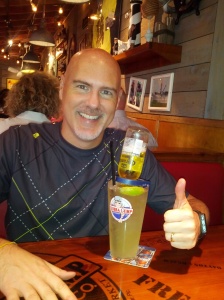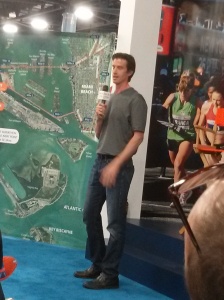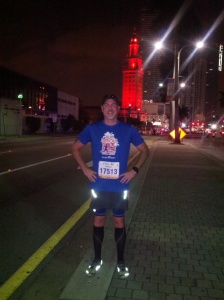2013 ING Miami Half Marathon
Travel & Lodge
 My wife and I flew into Miami, Florida on the Friday before the race at approximately mid-day. We were greeted by a beautiful blue sky filled with popcorn-like, white puffy clouds, and a $40 cab fare from the airport to the hotel. I booked our hotel several months ago based basically on a single criteria, its proximity to the start-finish line. Luckily for us, the Holiday Inn Port of Miami was 3 blocks from the start line and 2 blocks from the finish.
My wife and I flew into Miami, Florida on the Friday before the race at approximately mid-day. We were greeted by a beautiful blue sky filled with popcorn-like, white puffy clouds, and a $40 cab fare from the airport to the hotel. I booked our hotel several months ago based basically on a single criteria, its proximity to the start-finish line. Luckily for us, the Holiday Inn Port of Miami was 3 blocks from the start line and 2 blocks from the finish.
My stomach had started feeling a little uneasy the day before our trip but I wasn’t too concerned since I wasn’t suffering from any other symptoms such as headache, fever or sinus issues. I already had enough on my plate stressing over the recent shin splint appearance, not to mention the normal first-time big race paranoia over training, fitness, and whatever else could theoretically throw a wrench in my plans.
 We arrived too early to check in to our room so we headed across the street to the Bayside Market Place where we decided to have a single, large splurge meal before I had to go on pre-race lock down. We settled on the Bubba Gump Shrimp Factory and while I didn’t necessarily care for the over the top Forrest Gump theme or the lack-luster service, the shrimp scampi was filling and tasty. We also each enjoyed a Corona-Rita, which is a bottle of Corona beer suspended upside down over a glass partially filled with margarita mixer. If I wasn’t registered to run a half marathon two days later I could have sat right in that chair for the duration of the weekend.
We arrived too early to check in to our room so we headed across the street to the Bayside Market Place where we decided to have a single, large splurge meal before I had to go on pre-race lock down. We settled on the Bubba Gump Shrimp Factory and while I didn’t necessarily care for the over the top Forrest Gump theme or the lack-luster service, the shrimp scampi was filling and tasty. We also each enjoyed a Corona-Rita, which is a bottle of Corona beer suspended upside down over a glass partially filled with margarita mixer. If I wasn’t registered to run a half marathon two days later I could have sat right in that chair for the duration of the weekend.
Unfortunately, my stomach’s previous rumblings were not a false alarm and for the next 3 days, no matter what I ate or drank, I would have to make a direct path for the bathroom within 30 minutes or risk public humiliation.
The Expo
I had planned on just relaxing after lunch on Friday and heading over to the Expo on Saturday afternoon so I could catch a talk by Matt Fitzgerald, co-author of one of my favorite books on running. But as it turned out, the hotel employee who was checking us in was also running the half marathon and we struck up quite the conversation, during which he constantly recommended that we go to the Expo immediately so we could register my wife for the Tropical 5k, scheduled to be run at 7:30 am on Saturday morning.
We took the free shuttle over to the Expo and it was a nicely laid out event with all of the typical and expected vendors hawking their goods and offering free samples of their products. I was adamant about not trying any of the energy gels, shots, gummies, etc so as to avoid any bad reactions, and instead we focused on purchasing a few items of clothing and other memorabilia.
And then it happened! While I was collecting my registration packet my wife told me she was walking over to sign up for the 5k event. I was excited for her but honestly also slightly concerned about the logistical issues since the race did not start or finish near our hotel. We wrapped things up fairly quickly at the Expo and headed back to the hotel turn in early after starting the travel day at 3 am.
Tropical 5k & Expo Day 2
We woke up at 5 am on Saturday, choked down some coffee and a PowerBar headed out on our adventure hunt to find the 5k race. We ran into another couple about 15 minutes into our trip, and then a runner visiting from Germany, and then another couple, from Brazil. No one knew how to find or get to the Miami Children’s Museum on foot from where we were. I knew we were in deep trouble when a BMW pulled up beside us and the occupants rolled down the windows and asked us if we knew how to get to the race because they were official event media personnel and were lost.
 We walked about 5k through less than ideal neighborhoods and highways overpasses before running into a shuttle service at Parrot Jungle that took us to the race. I stayed on the bus and rode it to the finish line of the point to point race so I could wait for my wife. She cruised through in a personal best for her, all smiles, and looking great. Congrats baby! Great atmosphere at both the finish line and the after-party which took place at Nikki Beach.
We walked about 5k through less than ideal neighborhoods and highways overpasses before running into a shuttle service at Parrot Jungle that took us to the race. I stayed on the bus and rode it to the finish line of the point to point race so I could wait for my wife. She cruised through in a personal best for her, all smiles, and looking great. Congrats baby! Great atmosphere at both the finish line and the after-party which took place at Nikki Beach.
We left pretty early to get back to the hotel, clean up and shop a little for the kids and extended family before heading back out to the Expo so I could catch Matt’s speech about the “art and science of pacing.” He gave a great talk, took questions after and I even managed to pin him in a corner for some last minute strategy advice as well as an autograph for my copy of Run Faster from the 5k to the Marathon.
Rookie Mistakes
I did the best I could avoiding common pitfalls that sabotage unsuspecting or undisciplined racers. I didn’t drink any alcohol other than my single beer on Friday. I stayed away from sampling new and exciting products from highly energetic Expo vendors, and then I let my goofy, dumb-ass pride kick in.
There was a beautiful blue, race-themed tech shirt for sale. And I started rationalizing how it might be easier for my wife to spot me in the race if I wasn’t wearing the official orange shirt like 25,000 other runners. Plus I could then puff my chest out and wear the orange shirt during our flight home on Monday, bragging to the world about my exploits.
 Well, what do you know? By about mile 7 my nipples were raw. So raw that I was occasionally grabbing at my shirt to pull the fabric away from my chest rather than let it drag across my chest again.
Well, what do you know? By about mile 7 my nipples were raw. So raw that I was occasionally grabbing at my shirt to pull the fabric away from my chest rather than let it drag across my chest again.
Since I was feeling flat from all of my digestive issues I made a last minute to decision to abandon my strategy of running with a pace group targeting a 2:20 finish. Instead I decided to program a 13.1 mile workout into my Garmin, and assign various pace ranges to several segments so I could be reminded of an overall strategy without feeling the pressure of running with a group or constantly glancing at my watch.
Unfortunately, I did not realize or forgot that this would cause the Garmin to not give me 1 mile split times but instead provide only 3 splits referencing the 6 mile, 4 mile and 5k segments I had programmed. A real bummer not to be able to waste a few hours staring at my first ever half marathon split times from start to finish.
The Race
Finally! We get to what you came here for.
The corrals opened at 5 am and I walked outside the hotel with my wife at about 5:15. It was literally 10° hotter than it had been the past 2 days and I immediately shed my jacket and took a few last sips of water.
We walked around a bit together as I jogged and performed some dynamic stretches. She snapped photos and did a great job of capturing the atmosphere. I decided to search out my corral and she climbed the stairs of the American Airlines Arena to stake out an observation post for the start.
 After the requisite opening ceremonies, we were off and walking…..shuffling….walking…….the wait wasn’t too bad however and by the time that I made my way to the timing mat I was actually running.
After the requisite opening ceremonies, we were off and walking…..shuffling….walking…….the wait wasn’t too bad however and by the time that I made my way to the timing mat I was actually running.
Maybe the best decision I made the entire weekend was to abandon the pace group idea and just let the race come to me. I didn’t feel great and the adrenalin wasn’t jacking me up either. I felt ok, but guarded and cautious, and I was happy that I had programmed a somewhat more conservative approach into my Garmin, as opposed to hitting my goal pace right out of the chute with a group of strangers.
It literally took me until mile 3 before I felt somewhat relaxed. I also made a promise to drink at every aid station, thinking that my constant bathroom issues plus the higher temperatures would drain me faster than I had prepared for. At the first aid station I grabbed a cup of Gatorade on the run and promptly spilled the majority of it down my shirt on over my face. From that point forward I would walk whatever distance was necessary to drink the actual contents of whatever cup I decided to grab.
As a big race rookie, navigating the aid station mayhem was a bit disconcerting. Large groups of people mobbed the first table at each aid station creating human blockades that obstructed runners who were caught on the inside lane. Timing my dash into the later tables at each station became a fairly technical game of guess-timating angles, speeds and distances in order to successfully hydrate while avoiding crashing into other runners.
There were a couple of aid stations throughout the course that were not prepared or re-stocked by the time I came rambling by, but for the most part I’d have to say the volunteers, aid and effort were great and I can’t really complain that anything they did or didn’t do had any effect on my results. They had a hard job all day and performed it well. Thanks!
My only other critical observation during the race is in regards to the Galloway, run-walk interval participants. They were strong, disciplined and plentiful. But they also seemed to insist on running shoulder to shoulder, spanning a large width of the available course at any given time. And of course, just like clockwork, they became a walking roadblock. If you’re in a group of 6 plus people who know that you’re going to walk every 4 minutes or whatever your schedule is, can you please be aware of the fact that a long narrow rectangle of people is easier for other racers to navigate than is a wide, unyielding mass of elbows and backsides? Please?
I was determined to follow the advice of going out slow and running the first half of the race conservatively. I ran the first 6 miles without even considering an increase in pace. And interestingly enough I felt better physically at mile 6 than I did at mile 2. Over the next 4 miles I knew that I wanted to make a slight effort at increasing my pace but each time I tried to hold a new pace I’d find myself zigging and zagging among the crowd and feeling like I was wasting a lot of energy. So instead I decided to start surging between every second or third stoplight. I was feeling great and noticed that I was seeing mostly 10:xx + on my watch instead of 11:xx.
It was during this 3 to 4 mile stretch that I began fantasizing about what it would take to still hit a 2:20 or better finish. Could I turn a fartlek style second half into a respectable finish? Or if I found an opening in the course could I sustain a smooth transition to another gear and cruise through the final 5k at a 30 minute or better split?
I’d never find out. Somewhere between mile 10 and 11 my right hip began to tighten significantly. It was becoming harder and harder to drive my knee through, and I felt like I was leaving my right leg behind me at times. I’m proud that I didn’t panic or just give up but it would be a lie if I said that I wasn’t frustrated knowing that my chance to turn an average effort into a respectable PR was disappearing quickly.
The final 2.5 miles or thereabouts were really just about not slipping into crash and burn territory. I kept trying to remember a quote I read somewhere along the lines of, “the runner who can run the longest, and the fastest, while in the most discomfort, while staying the most relaxed will be the winner.”
My idea of winning at that point was digging in for a final, sub 10:00 mile or squeezing through the 2:20 window somehow but it wasn’t to be. I just lacked the extra gear that more focused training wold have provided and I lacked the mental fortitude to ignore my hip for the final 5k.
 I’m not necessarily disappointed. I beat my realistic goal of 2:30 and I did so knowing that there’s a lot more potential waiting to be exposed. But it won’t happen magically or just because I want it. I have to make it happen.
I’m not necessarily disappointed. I beat my realistic goal of 2:30 and I did so knowing that there’s a lot more potential waiting to be exposed. But it won’t happen magically or just because I want it. I have to make it happen.
Running may very well be the most honest game on earth. It won’t give you anything that you haven’t earned but it will give you exactly what you deserve.
The After-Party
Bottled water. Bananas. Bagels. Fruit cups. Medals. Pictures. Some band playing. Rice and beans. A beer tent that was too far away. A bright sun and green grass. Stretching against a tree. Finally finding my wife. A shower and change of clothes. Three cheese ravioli x 2. A 3 hour nap.
Gear
Brooks PureConnect
CEP Progressive Compression Socks
Garmin Forerunner 610 w/ HR monitor
Splits
Split 1, 1:07:07, 6 miles, avg pace 11:11, avg HR 156, max HR 171
Split 2, 42:09, 4 miles, avg pace 10:38, avg HR 170, max HR 177
Split 3, 32:07, 3.1 miles, avg pace 10:27, avg HR 178, max HR 182
###






